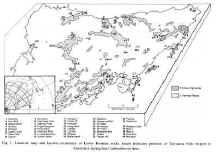Sedimentary Geology, 64 (1989), 25-41
SEDIMENTOLOGY OF THE COLD-CLIMATE, COAL-BEARING, LOWER PERMIAN "LOWER
FRESHWATER SEQUENCE" OF TASMANIA
I.P. MARTINI1 and M.R. BANKS2
1Department of Land Resource Science, University of Guelph, Guelph,
Ont. N1G 2W1 Canada)
2Department of Geology, University of Tasmania, Hobart, Tasmania 7001
(Australia)
¡¡
 The Lower Permian "Lower Freshwater Sequence" of Tasmania consists
of fluvial and coastal sediments deposited in a cold-climate setting adjacent to
ice-ridden, shallow seas. The sequence represents a regressive pulse during the
filling of a marine basin, possibly a fjord, up to 150 km wide and more than 270
km long, occupied by glaciers in the late Carboniferous.
The Lower Permian "Lower Freshwater Sequence" of Tasmania consists
of fluvial and coastal sediments deposited in a cold-climate setting adjacent to
ice-ridden, shallow seas. The sequence represents a regressive pulse during the
filling of a marine basin, possibly a fjord, up to 150 km wide and more than 270
km long, occupied by glaciers in the late Carboniferous.
The climatic conditions
during the early Permian in Tasmania are revealed by (1) well-developed
continental scree breccias, (2) the flora (Glossopteris-Gangamopteris assemblage),
(3) rarity of fossils in tidal deposits, (4) the structure of the trace fossil
population (intense bioturbation in offshore muds), (5) the foramol nature of
the fauna of the marine beds below and above the Lower Freshwater Sequence, a
fauna dominated by brachiopods and bryozoa and containing Eurydesma, and
(6) features of the sediments themselves, such as "lonestones" in
muddy offshore marine deposits, and oxygen isotopes of associated marine
carbonates.
Although the sedimentation in the Lower Freshwater Sequence
is qualitatively analogous to that of the Quaternary of Canada, the fluvial and
coastal sediments do not show evidence of ice rafting nor of frozen ground. Lack
of such evidence suggests a cold-temperate rather than a subpolar setting.